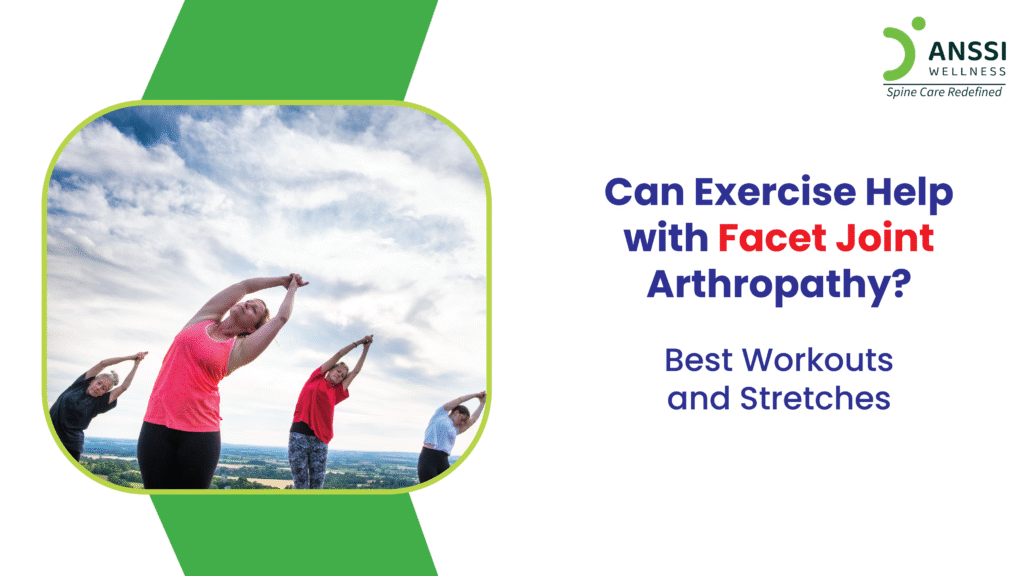Facet joint arthropathy is a degenerative spinal condition that affects the small joints located between each vertebra. These joints help guide and stabilise movement in the spine, and when they begin to wear down, due to age, injury, or repeated stress, they can become inflamed and painful. This condition can lead to stiffness, lower back pain, and reduced mobility, particularly with prolonged sitting or standing.
While periods of rest are important during painful flare-ups, research and clinical experience show that regular, low-impact exercise is one of the most effective ways to manage and reduce symptoms in the long run. The right combination of stretches and strengthening exercises can support your spine, improve flexibility, and reduce pressure on the facet joints, helping you move more freely and live with less pain.
How Exercise Supports Facet Joint Health
Exercise might not “cure” facet joint arthropathy, but it plays a crucial role in managing it by:
Maintaining flexibility
Regular stretching keeps the joints mobile and prevents stiffness that can worsen pain. It also helps reduce muscle tension in the lower back.
Strengthening supporting muscles
A strong core, glutes, and back muscles take pressure off the spine. This support reduces the load on facet joints during daily activities like walking, standing, or bending.
Improving circulation and reducing inflammation
Movement increases blood flow to spinal tissues, promoting healing and reducing inflammation around irritated joints.
Guidelines Before You Begin
Before starting any exercise routine, it’s important to follow a few key guidelines to ensure your safety and effectiveness:
Consult a specialist
Always check with your spine doctor or physiotherapist to confirm that exercise is safe and appropriate for your condition. They can tailor a plan to your needs.
Avoid high-impact or twisting movements
Running, jumping, or twisting at the waist can aggravate facet joint pain. Stick to slow, controlled, low-impact exercises.
Start slow and stay consistent
It’s better to begin with short sessions and build gradually. Consistency is more beneficial than intensity when it comes to chronic spinal conditions.
Best Stretches for Facet Joint Relief
Here are some gentle stretches designed to relieve pressure and improve mobility in the spine:
Cat-Cow Stretch
This classic yoga movement improves spinal flexibility and warms up the spine.
- Start on your hands and knees in a tabletop position.
- Take a deep breath, raise your head and tailbone, and arch your back (Cow Pose).
- Tuck your chin to your chest, round your back, and exhale (Cat Pose).
- Repeat 8-10 times, moving smoothly between the two poses.
Child’s Pose
A calming stretch that opens the lower back and relieves tension.
- Sit back on your heels while kneeling on the ground.
- Lower your torso and extend your arms forward.
- Hold the stretch for 20–30 seconds.
Knee-to-Chest Stretch
This movement gently lengthens the lower back muscles.
- Bring one or both knees to the chest while lying on your back.
- Hold the position for 20-30 seconds.
Pelvic Tilts
This exercise strengthens the core and gently mobilizes the lumbar spine.
- Lie on your back with your knees bent.
- Tighten the abdominal muscles to flatten your back against the floor.
Strengthening Exercises to Support the Spine
Building strength in key muscle groups helps to offload stress from the facet joints.
Bridges
Targets the glutes and lower back.
- Lie on your back while keeping knees bent and feet flat.
- Lift your hips off the ground while tightening your core, so that your shoulders and knees are aligned in a straight line.
- Hold for 5 seconds, then lower.
- Repeat 10-15 times.
Bird-Dog
Improves core strength and balance.
- Begin on all fours and alternate extending the opposite arm and leg.
- Hold briefly before switching sides.
- Repeat 10–12 times per side.
Wall Sits
Strengthens the thighs, hips, and lower back.
- Stand against a wall.
- Slide down slowly to make your thighs parallel to the ground.
- Hold for 20-60 seconds.
About ANSSI:
ANSSI Wellness focuses on improving the quality of life for patients suffering from spinal issues, aiming to provide relief where other conventional treatments have failed. Through advanced non-surgical spinal decompression treatment, ANSSI is committed to helping patients avoid surgery and recover in a safe, effective, and compassionate environment.
Connect with ANSSI Wellness on LinkedIn, Instagram, and Facebook for expert guidance.




